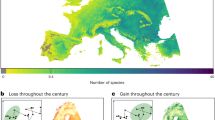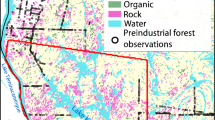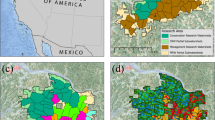Abstract
California timber production has been declining in an era of warming, increased wildfires, land conversion, and growing emphasis on recreation. Climate change has the potential to further affect California timber production through changes in individual tree growth rates, forest dieback, and shifts in species ranges and ecosystem composition. Coupled with changes in global timber prices, themselves the result of productivity effects, these production impacts hold important consequences for California’s private timberlands. This study uses models that project tree species productivity and movement across the landscape under climate change, coupled with economic models of landowner adaptation and returns from multiple harvest strategies. Our results show that under likely price scenarios, climate change will result in an overall decline in harvested timber value relative to no climate change, with decreases of 4.9 to 8.5% by the end of the century. The magnitude of decrease depends on climate change scenario, price scenario and management option – with dollar losses totaling up to $8.1 billion in total land value (−$2.7 billion given a 4% discount rate). There is substantial spatial variation in these changes; most areas show significant declines in timber value while some show modest increases relative to a no climate change baseline. If prices are not affected by climate change, more areas experience gains in value. We find that forestry management strategies can mitigate lost value, indicating that climate change adaptation programs can yield important economic benefits. Declining timber value corresponds disproportionately to areas already experiencing timberland conversion to housing or agriculture. Policy measures to stem conversion of devalued timberlands may warrant consideration.






Similar content being viewed by others
Notes
A self-thinning relationship has been observed in a broad range of plant species, in which a unit decrease in density will occur for every 1.5-unit increase in biomass (Li et al. 2000).
If we were to apply a 4% discount rate, given the value changes over time specified in Table 2, our non-discounted value change of -$8.1 billion would translate to -$2.7 billion.)
References
Alig R, Adans D, McCarl B, Callaway JM, Winnett S (1997) Assessing effects of mitigation strategies for global climate change with an intertemporal model of the U.S. Forest and Agriculture Sectors. Environ Resource Econ 9:259–274
Busing RT, Fujimori T (2005) Biomass, production and woody detritus in an old coast redwood (Sequoia sempervirens) forest. Plant Ecol 177:177–188
California State Board of Equalization (2010) California timber harvest statistics. http://www.boe.ca.gov/proptaxes/pdf/harvyr2.pdf
Callaway J, Smith J, Keefe S (1994) The economic effects of climate change for U.S. forests. U.S. Environmental Protection Agency, Adaptation Branch, Climate Change Division, Office of Policy, Planning, and Evaluation, Washington
Coops NC, Waring RH, Moncrieff JB (2000) Estimating mean monthly incident solar radiation on horizontal and inclined slopes from mean monthly temperature extremes. Int J Biometeorol 44:204–211
Coops NC, Waring RH (2001) Assessing forest growth across Southwestern Oregon under a range of current and future global change scenarios using a process model, 3-PG. Glob Chang Biol 7:15–29
Joyce LA, Mills JR, Heath LS, McGuire AD, Haynes RW, Birdsey RA (1995) Forest sector impacts from changes in forest productivity under climate change. J Biogeogr 22:703–713
Joyce L, Aber J, McNulty S, Dale V, Hansen A, Irland L, Neilson1 R, Skog K (2001) Potential consequences of climate variability and change for the forests of the United States. Climate change impacts in the United States: the potential consequences of climate variability and change (Ch. 17). Cambridge University Press, Cambridge, UK
Koch GW, Sillett SC, Jennings GM, Davis SD (2004) The limits to tree height. Nature 428:851–854
Landsberg JJ, Waring RH (1997) A generalised model of forest productivity using simplified concepts of radiation-use efficiency, carbon balance and partitioning. For Ecol Manage 95:209–228
Landsberg JJ, Waring RH, Coops NC (2002) Performance of the forest productivity model 3-PG applied to a wide range of forest types. For Ecol Manage 172:199–214
Law BE, Waring RH, Anthoni PM, Aber JD (2000) Measurement of gross and net ecosystem productivity and water vapor exchange of a Pinus ponderosa ecosystem, and an evaluation of two generalized models. Glob Chang Biol 6:155–168
Li B-L, Wu H-I, Zou G (2000) Self-thinning rule: a causal interpretation from ecological field theory. Ecol Model 132(1–2):167–173
Mendelsohn R, Smith J (2006) The impact of climate change on regional systems: a comprehensive analysis of California. Elgar, Northampton
Perez-Garcia J, Joyce L, Binkley A, Clark S, McGuire A (1997) Economic Impacts of Climatic Change on the Global Forest Sector: An Integrated Ecological Economic Assessment. Reviews in Environmental Science and Technology. Boca Raton, FL: CRC Press.
Sands PJ (2001) 3PGPJS—a user-friendly interface to 3-PG, the Landsberg and Waring model of forest productivity. Tech. Rep. 29(2). CRC for Sustainable Production Forestry and CSIRO Forestry and Forest Products, Hobart, Tasmania
Spero J (2006) California timber yield tax volume and value trends: historical BOE timber harvest data by species, county, ownership. http://frap.cdf.ca.gov/projects/BOE/BOETimberTax.html
Sohngen B, Mendelsohn R, Sedjo R (2001) A global model of climate change impacts on timber markets. Am J Agr Econ 26(2):326–343
Sohngen B, Mendelsohn R (2003) An optimal control model of forest carbon sequestration. Am J Agr Econ 85(2):448–457
State Board of Equalization (2007) Harvest value schedule, effective July 1, 2007–December 31, 2007
Swenson JJ, Waring RH, Coops N, Fan W (2005) Estimation of forest productivity across the Pacific and Inland Northwest with a physiologically based process model, 3-PG. Can J Forest Res 35:1697–1707
Thuiller W (2003) BIOMOD- optimizing predictions of species distributions and projecting potential future shifts under global change. Glob Chang Biol 9:1353–1362
van Kooten C, Binkley C, Delcourt G (1995) Effect of carbon taxes and subsidies on optimal forest rotation age and supply of carbon services. Am J Agr Econ 77:365–374
Acknowledgments
C. Guo was supported by the ConvEne IGERT program of NSF.
Author information
Authors and Affiliations
Corresponding author
Electronic supplementary material
Below is the link to the electronic supplementary material.
Esm. 1
(DOCX 40 kb)
Rights and permissions
About this article
Cite this article
Hannah, L., Costello, C., Guo, C. et al. The impact of climate change on California timberlands. Climatic Change 109 (Suppl 1), 429–443 (2011). https://doi.org/10.1007/s10584-011-0307-2
Received:
Accepted:
Published:
Issue Date:
DOI: https://doi.org/10.1007/s10584-011-0307-2




